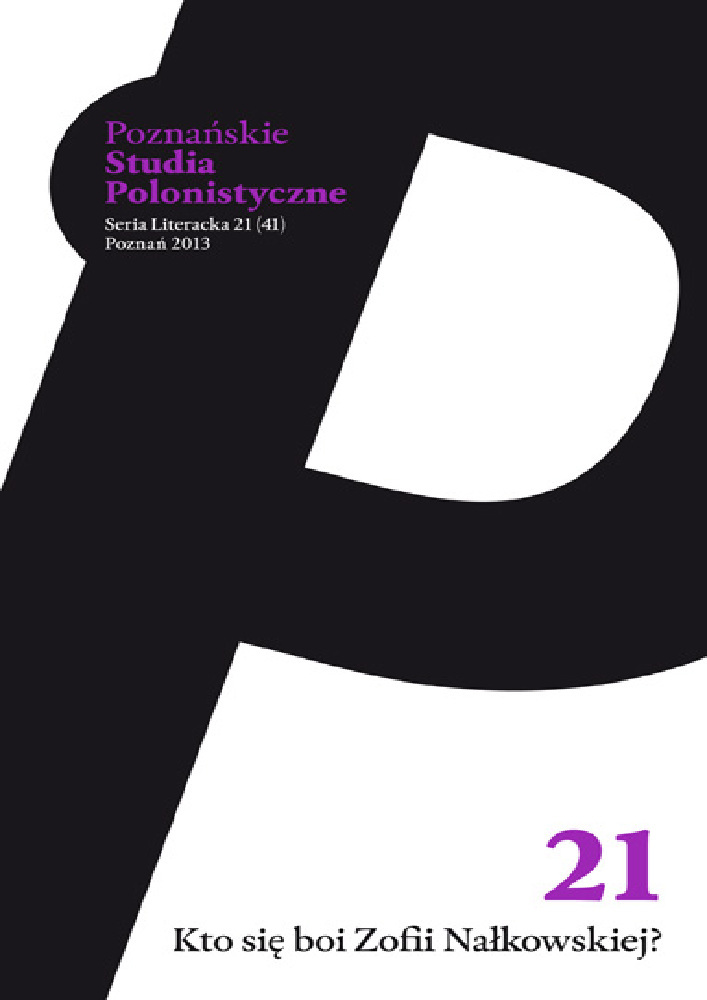Abstract
The author analyses the love-hate relationship between Zofia Nałkowska and her seven years’ senior, the legendary painter Maria Komornicka, who was for a time romantically ivolved with Zofia’s father — Wacław Nałkowski — and her friend — Cezary Jellenta. The relationship between the two writers has excited emotional reponses from researchers for many years. Two critics specializing in Komornicka have shown their interest most explicitly: Izabela Filipiak and Edward Boniecki. They accuse Nałkowska of not maginalizing Komornicka’s role in women’s literature of early 20th century, of unfeeling attitude for Komornicka’s tragic fate, even though Nałkowska was inspired by her in the early age, and of the failure to help Komornicka, when she was declared insane and disempowered after her symbolic transformation into a man. Researchers have so far seen Komornicka as a lost and harmed person, whereas Nałkowska was perceived as the morally questionable winner. However, Hanna Kirchner, who specializes in Nałkowska, has recently shown interesting sources of Nałkowska’s dislike for Komornicka, pointing out to a forgotten juvenile poem called Historia „Forpoczt”. The author of the article, who also wrote a monograph about Maria Komornicka, analyses the arguments presented by critics of both writers, observing the relation between Nałkowska and Komornicka from a neutral ground, without sharing the dynamic of hasty accusations.
References
Boniecki E., Modernistyczny dramat ciała. Maria Komornicka, Warszawa 1998.
Filipiak I., Obszary odmienności. Rzecz o Marii Komornickiej, Gdańsk 2006.
Galant A., Trupy na brzegu, „Pogranicza” 2011, nr 6, s. 56–57.
Helbig-Mischewski B., Strącona bogini. Rzecz o Marii Komornickiej, Kraków 2010.
Helbig-Mischewski B., Ein Mantel aus Sternenstaub. Geschlechtstransgress und Wahnsinn bei Maria Komornicka, Norderstedt 2004.
Jellenta C., Zapomniana awangarda, „Pion” 1935.
Kirchner H., Nałkowska albo życie pisane, Warszawa 2012.
Komornicka M., Utwory poetyckie prozą i wierszem, red. M. Podraza--Kwiatkowska, Kraków 1996.
Kralkowska-Gątkowska K., Cień twarzy. Szkice o twórczości Marii Komornickiej, Katowice 2002.
Zdanowicz K.E., Kto się boi Marii K.? Sztuka i wykluczenie, Katowice 2004.
License
Authors
Authors of texts accepted for publication in „Poznańskie Studia Polonistyczne. Seria Literacka” are required to complete, sign and return to the editor's office the Agreement for granting a royalty-free license to works with a commitment to grant a CC sub-license.
Under the agreement, the authors of texts published in „Poznańskie Studia Polonistyczne. Seria Literacka” grant the Adam Mickiewicz University in Poznań a non-exclusive, royalty-free license and authorize the use of Attribution-NoDerivatives 4.0 International (CC BY-ND 4.0)Creative Commons sub-license.
The authors retain the right to continue the free disposal of the work.
Users
Interested Internet users are entitled to use works published in „Poznańskie Studia Polonistyczne. Seria Literacka” since 2016, for non-commercial purposes only, under the following conditions:
- attribution - obligation to provide, together with the distributed work, information about the authorship, title, source (link to the original work, DOI) and the license itself.
- no derivatives - the work must be preserved in its original form, without the author's consent it is not possible to distribute the modified work, such as translations, publications, etc.
Copyrights are reserved for all texts published before 2016.
Miscellaneous
Adam Mickiewicz University in Poznań retains the right to magazines as a whole (layout, graphic form, title, cover design, logo etc.).
